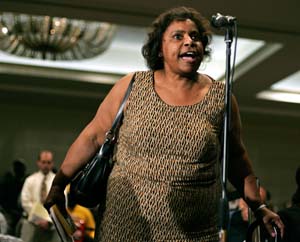
Vol. 70/No. 4
January 30, 2006
Working people in New Orleans
resist eviction effort by City Hall
(front page)

|
|
AP/Ben Margot
|
|
Carolyn Parker, a resident of New Orleans’s Lower Ninth Ward, speaks out at January 11 hearing against City Hall plans that would force thousands of working people to abandon their homes. “I don’t think it’s right that you take our properties,” she said. “Over my dead body.”
|
BY SAM MANUEL
NEW ORLEANS, January 16—Working people here took advantage of recent activities to express their determination to not be driven out of the city. From a jam-packed meeting at City Hall to the annual Martin Luther King Day march today in the predominantly Black and working-class section of the Lower Ninth Ward, they vowed to defy a proposal to impose a four-month moratorium on rebuilding their neighborhoods.
In an effort to assuage that anger, the mayor and members of the city council have distanced themselves from the proposal, which was put forward by a panel appointed by the mayor.
Most of the city was flooded for weeks after levees broke in the wake of Hurricane Katrina in August. Five months later tens of thousands of working people remain dispersed around the country.
Louisiana’s Democratic governor Kathleen Blanco immediately backed the proposal. New Orleans mayor Ray Nagin, who is Black and also a Democrat, initially said he would support it too. “As far as I am concerned, this plan is the way we are going to go, with some tweaks,” Nagin said, according to the Times Picayune.
Working people first expressed their outrage at the proposal—which includes a requirement that residents would have from four months to a year to prove their houses should not be bulldozed—at a January 11 hearing, where the Bring New Orleans Back Commission presented the plan. “I don’t know you, but Mr. Canizaro, I hate you,” said Harvey Bender, a laid off city worker from New Orleans East. Joseph Canizaro, a wealthy developer, authored the plan. “You’ve been in the background scheming to take our land,” Bender said.
During a heated meeting at City Hall on January 14 attended by 500 people, many of them from some of the hardest hit neighborhoods, Nagin said he is now “uncomfortable” with the four-month building moratorium. He told residents of Gentilly, Pontchartrain Park, and New Orleans East they should continue to rebuild for now.
“At the end of the day this city will be chocolate. It will still be a majority African-American city,” Nagin said a few days later during the city’s official King Day rally. That parade was changed from its traditional route, which begins in the Lower Ninth Ward. Nagin cited safety concerns for the change. Nevertheless about 200 people marched in the parade starting in the Lower Ninth Ward, which was organized by several groups that have been involved in helping residents clear their property, renovate homes, and file legal challenges to evictions.
Waiting for the parade to kick off, Lionel Smith condemned Nagin’s decision. “The King Day parade began here before it became official,” he said. “No storm and no mayor will stop us from having King Day in the Lower Ninth.” The New Orleans NAACP president and several city council members attended the activity.
“They tell you: collect your insurance money, get your $30,000 from FEMA—or leave!” Emanuel Borden told the Militant. “They want your land. Me, personally, I’m here to stay.” Borden was among the thousands who stood along Broad St. waiting for the “Second-line” march of traditional New Orleans jazz bands to commemorate King’s birthday with a focus on the “rebirth” of the city. The march wound through parts of New Orleans where neighborhoods remain uninhabited.
Borden’s rental home was demolished by the flooding. “I lived just four blocks from where the levee broke through the Industrial Canal into the Lower Ninth Ward,” said Borden, a pipefitter back to work at the Avondale shipyards. “They had over 6,000 before Katrina hit, now about 4,000 of us are back,” he said, adding that Northrop Grumman, the owner, set up a camp at Avondale, which is still home to many workers. “They’re not allowed to bring their families, so most go to visit on the weekends in Houston, Baton Rouge, or other cities,” he noted, adding he is currently housed in a hotel near the shipyard.
“I have a contractor ready to do the work but I can’t get permits,” said Charles Blandon as he sifted through the remains of his home in the Lower Ninth Ward. “The moratorium is already in effect.” Former residents there say they are only allowed to visit to determine the extent of damage to their homes and to retrieve valuables.
Blandon is also concerned about the city’s new flood elevation plan, which could require him to raise his house a foot or more in order to be eligible for flood insurance. “I got an estimate of $100,000 to do that. How can people down here afford that on top of the cost to rebuild?” he asked.
Tony Dutrow from Houston contributed to this article
Front page (for this issue) |
Home |
Text-version home

